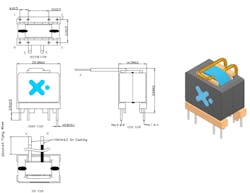GaN-Based USB-C Ref Design Uses Half-Active Bridge to Deliver 96% Efficiency
What you’ll learn:
- Pulsiv's reference design for a 65-W USB-C converter uses an integrated GaN device and innovative magnetics to deliver up to 96% efficiency.
- The reference design's higher efficiency enables it to run significantly cooler than conventional converters.
- It offers 20% space savings over typical 65-W converter designs.
The August edition of PowerBites included a brief summary of Pulsiv Limited's super-efficient* 65-W, USB-C, GaN-optimized reference design. However, there was so much more to the story that it seemed worthwhile to share a closer look at some of the unique features it offers, and how they can help designers address the complex thermal, space, and pricing challenges associated with today's power supplies (Fig. 1).
The PSV-RDAD-65USB reference design uses Pulsiv OSMIUM technology to create an industry-standard QR flyback circuit that, when combined with highly optimized, ultra-compact magnetics, forms a compact, cool-running, 65-W USB-C power converter capable of delivering up to 96% efficiency. It represents the first in a series of designs aimed at pushing the boundaries of power conversion by drastically lowering operating temperatures, minimizing losses, and reducing size to create a sustainable platform for the USB-C standard.
Half-Active Bridge Topology Optimizes Space and Efficiency
The converter uses Pulsiv's OSMIUM technology to sense AC line voltage and frequency to adjust capacitor charging time, ensuring the circuit draws no line current at the AC zero-voltage crossing. This permits the use of a simple half-active bridge implementation that increases overall efficiency, especially at low line conditions (Fig. 2).
The MOSFETs in the lower half of the AC-to-DC bridge are carefully controlled, in combination with high-side diodes. The half-active bridge topology used in this design represents a highly optimized tradeoff between efficiency, cost, and complexity. In addition, it supports universal input (90-265 V AC, 50/60 Hz) while delivering efficiency gains of 0.7% at full load from a 115-V AC supply.
Innovative Magnetics Shrink Transformer Size by 20%
Pulsiv's reference design uses its OSMIUM conversion technology to generate a HVDC output that varies between the peak AC input and 150 V to drive the QR flyback at maximum efficiency. The wider voltage range substantially reduces primary-side inductance to enable the use of an EQ20 transformer, which was developed in partnership with magnetics expert Frenetic (Fig. 3).
This results in a 20% size reduction and 50% efficiency improvement compared to an RM8 core typically used in other designs.
Achieving Ultra-Cool Operation and Fast Charging
By combining integrated gallium-nitride (GaN) technology and innovative magnetics, the Pulsiv OSMIUM reference design is able to reduce critical component temperatures by more than 30% (Fig. 4a), as compared to other designs (Fig. 4b). At full load, the flyback transformer reaches 33.9°C at 230 V AC and 30.3°C at 265 V above an ambient temperature of 26.1°C.
That capability is expected to open up new possibilities for applications requiring 65-W fast charging in space-constrained environments and/or heat-sensitive applications such as in-wall plug sockets that incorporate USB-C connectivity.
Featured specifications of the reference design include:
- Input voltage range: 90 to 265 V AC (no input voltage derating)
- Output voltage: 5 to 20 V DC supporting PD3.0, QC4.0, BC1.2, and PPS (fast charging)
- Output power: 65 W max
- Transformer temperature: 30.3°C above ambient
- Operating frequency: 125 kHz
- Peak efficiency: 96%
- Average efficiency: 95%
- Line current: 0.5 A max
- Inrush current: Eliminated
- DC-DC converter: Quasi-resonant (QR) flyback
Design Package and Evaluation Boards Available
The PSV-RDAD-65USB document package is available to download free from the Pulsiv website. Included are a datasheet, schematics, bill of materials, and Altium files. The PSV-EBAD-65USB evaluation board enables rapid lab testing and can be pre-ordered now for delivery through a network of franchised distribution partners such as DigiKey.
*Efficiency based on peak thermal measurements at full load after 30 min.
About the Author
Lee Goldberg
Contributing Editor
Lee Goldberg is a self-identified “Recovering Engineer,” Maker/Hacker, Green-Tech Maven, Aviator, Gadfly, and Geek Dad. He spent the first 18 years of his career helping design microprocessors, embedded systems, renewable energy applications, and the occasional interplanetary spacecraft. After trading his ‘scope and soldering iron for a keyboard and a second career as a tech journalist, he’s spent the next two decades at several print and online engineering publications.
Lee’s current focus is power electronics, especially the technologies involved with energy efficiency, energy management, and renewable energy. This dovetails with his coverage of sustainable technologies and various environmental and social issues within the engineering community that he began in 1996. Lee also covers 3D printers, open-source hardware, and other Maker/Hacker technologies.
Lee holds a BSEE in Electrical Engineering from Thomas Edison College, and participated in a colloquium on technology, society, and the environment at Goddard College’s Institute for Social Ecology. His book, “Green Electronics/Green Bottom Line - A Commonsense Guide To Environmentally Responsible Engineering and Management,” was published by Newnes Press.
Lee, his wife Catherine, and his daughter Anwyn currently reside in the outskirts of Princeton N.J., where they masquerade as a typical suburban family.
Lee also writes the regular PowerBites series.





